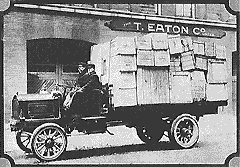 |
|
Eaton Delivery Truck, 1905 |
Toronto and Montreal spend a century jostling for first place as the business capital of Canada. Toronto is the runt of the race - a muddy, snoozy backwater until half way through the 19th century. Partly it's because Toronto's business elite strangles growth and competition through its own self interest. These privileged businessmen are members of a closed circle called the Family Compact. Men like John Strachan, John Robertson and William Allan, run the banks and businesses; in fact, they ran Upper Canada from Toronto. Eventually their influence fades in the rough and tumble of newer ideas and bigger numbers of entrepreneurial immigrants. After Confederation, Toronto bankers lobby to rein in the power of the Bank of Montreal. In 1871 the federal government brings in the Bank Act, enabling local banks to grow and local businesses to get the loans they need to prosper.
 |
|
Cobban Manufacturing, 1890 B Rolph Smith & Co., Toronto |
Toronto abounds with stories of rags to riches and riches to rags. Massey Harris supplies the farm equipment that helps immigrants settle the west. Irishman Timothy Eaton introduces fixed pricing and "Goods satisfactory or money refunded" - a policy that keeps the competition honest. His catalogue is called "The Prairie Bible." Sir Henry Pellat (the Plunger) makes a killing speculating in the West, builds Casa Loma, then dies penniless.
 |
|
The Dominion Bank, Head Office, 1878 |
Businessmen grow innovative and daring. Sir Henry Pellat harnesses hydro power from Niagara; Eaton starts manufacturing his own clothes; Ted Rogers Sr. invents a batteryless radio; John Inglis and Massey Harris perfect munitions manufacturing during the war years. The manufacturing sector explodes and by 1967, Toronto has two-thirds of Canada's manufacturing capacity.
While Montreal prides itself as the financial capital, Toronto slowly but surely overtakes it. Many banks are born here: The Bank of Upper Canada in 1823, the Dominion (later the Toronto Dominion), Imperial and National Trust. By the 1960s, three of the five national banks are headquartered in Toronto. The TD Centre is erected in 1969, and stands as the tallest building in the Commonwealth.
 |
|
Light Trading on the Toronto Stock Exchange, 1973 by William Kurelek |
It is James Austin, a founder of the Dominion Bank, who introduces a new concept in banking that has far-reaching consequences. Austin opens the first branch office in Toronto, offering customers the convenience of local banking and sparing them the long trip downtown. Other banks soon follow.
In 1972, Toronto's wealth is greater than anywhere in the country. Metro pays more income taxes than any of the 10 provinces except Ontario and Quebec. The Metro budget bulges bigger than the budget of seven of the provinces. By 1976, Toronto finally edges out Montreal's population and is the largest city in Canada.
Next: Sports
|
